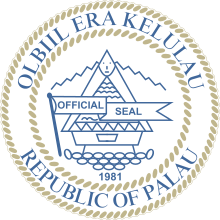Supreme Court of Palau
The Supreme Court of Palau is the highest court of Palau. Article X of the Constitution vests the Supreme Court with judicial power and provides for its operation and jurisdiction.[1] The Supreme Court is divided into a Trial Division and an Appellate Division. Cases are adjudicated by a single justice in the Trial Division and appeals are heard by panels of three different justices in the Appellate Division. The Trial Division of the Supreme Court has jurisdiction over all civil matters over $10,000 and criminal matters not assigned to the Court of Common Pleas and adjudication of land interests. The Supreme Court also handles disciplinary and other special proceedings. The Supreme Court comprises a Chief Justice, Arthur Ngiraklsong, and three Associate Justices, Kathleen M. Salii, M. Lourdes Materne, and R. Ashby Pate. Other judges are invited to sit on an as-needed basis as Associate Justices Pro Tem or Part-Time Associate Justices.[2]
 |
|---|
| This article is part of a series on the politics and government of Palau |
|
History
Palau Supreme Court was created in 1981, pursuant to Article X of the Constitution. Mamoru Nakamura was the first Chief Justice of the Supreme Court. Educated in Hawaii and Oregon, Justice Nakamura worked in a variety of legal capacities in Micronesia before being appointed the first Micronesian Associate Justice of the High Court of the Trust Territory of the Pacific Islands. He served as Palau's first Chief Justice from 1981 until his death in 1992. In 1992, President Ngiratkel Etpison appointed to the Supreme Court the current Chief Justice, Arthur Ngiraklsong.
The Court sits in Koror, with certain arguments being heard forty-five minutes away in Palau's capital, Melekeok. The building housing the Court in Koror was built by the Japanese Administration, beginning around 1922. The building served as the Palau District Branch government building, and included tax collection and administration offices. The basement of the building served as a jail, and a formal garden filled an interior yard. The building also housed a local court, presided over by one judge. The South Seas Administration appellate court was also located in Koror. The judge of the Koror local court also served as the Chief Justice of the Appellate Court.
While much of Koror was destroyed in World War II, the Court building survived. In recent years, the Court complex has expanded, with annexes named after Pablo Ringang, presiding judge of the Justice Court and the District Court, and after former Chief Justice Nakamura. The complex now houses the Court of Common Pleas, courtrooms and chambers for all four Supreme Court Justices, and the Singichi Ikesakes Law Library (named for the first Presiding Judge of the Court of Common Pleas), as well as Offices for the Clerk of Courts, Administrative Director, Marshals, Probation Officers, Attorney General and Public Defender.
References
- "Organization". Judiciary of Palau. Retrieved 22 December 2013.
- "Associate Justices". Judiciary of Palau. Retrieved 22 December 2013.